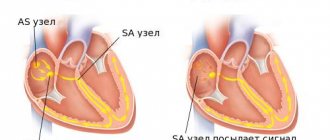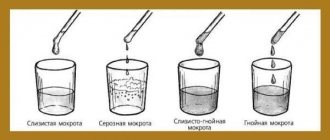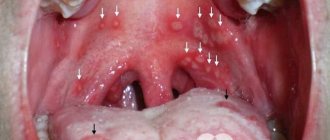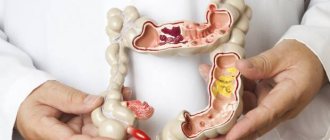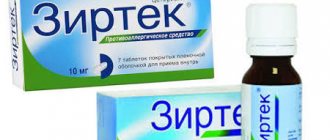Tracheobronchitis means a pathology of the respiratory tract, which is characterized by the appearance of an inflammatory process in the bronchi, bronchioles and trachea. In most cases, this disease is a complication of ARVI, and in very rare cases it can be an independent disease.
This is a very common disease that absolutely anyone can encounter. The peak incidence is the off-season and the period of epidemic of acute respiratory viral infection.
Etiology
Tracheobronchitis - inflammation of the bronchi and trachea caused by viruses and bacteria
Infection is the root cause of tracheobronchitis. The causative agents of the disease are:
- Viruses - influenza, adenoviruses, parainfluenza, rhinoviruses, respiratory syncytial virus.
- Bacteria - Haemophilus influenzae, staphylococci, klebsiella, streptococci, moraxella, pneumococci, mycoplasma, pseudomonas.
Bacteria in tracheobronchitis manifest their activity after the body is damaged by viruses.
Ways of infection with tracheobronchitis:
- hematogenous;
- aerogenic;
- bronchogenic.
As a result of tracheobronchitis, there is a high probability of infecting other people with the disease. For this reason, precautions must be taken to prevent the spread of infection through the respiratory route.
The causes of the disease may be:
- alcoholism;
- hypothermia;
- smoking;
- stress;
- avitaminosis;
- wrong lifestyle;
- inflammation of the tonsils, sinuses, pharynx;
- sanitation of the body;
- poor nutrition;
- overwork;
- contact with patients,
- bad ecology;
- hereditary tendency to diseases;
- deformation of the chest and nasal cavity;
- lack of sun;
- typhoid fever, whooping cough.
The nose is designed to warm cold air and cleanse it. Dust settles in the nasal sinuses and is expelled when sneezing. Diseases of the respiratory system and nasal cavity do not allow the full use of self-cleaning mechanisms, as a result, breathing becomes difficult. Unpurified and cold air entering the larynx and trachea leads to hypothermia and irritation. This leads to inflammation of the trachea, larynx and tracheobronchitis.
Tracheobronchitis in acute form is accompanied by swelling of the mucous membrane of the trachea and bronchi, accumulation of sputum, its infiltration and the formation of hemorrhage.
With chronic tracheobronchitis, dystrophic reactions develop - atrophy and hypertrophy. With atrophy, the mucous membrane oozes and gray crusts form.
With hypertrophic tracheobronchitis, the mucous membrane swells, blood flows expand, and purulent sputum and mucus form.
Forms of tracheobronchitis
Tracheobronchitis can develop due to infection, allergies, smoking, poor environment
Allergy - infectious tracheobronchitis - develops when an infection enters the body. Allergies are formed as the body’s reaction to the appearance of microbial antigens.
The peculiarity of allergic tracheobronchitis is that the person is in good condition with symptoms such as: severe itching, hoarse voice, cough.
The usual form of tracheobronchitis affects people living in areas with unfavorable atmosphere.
The acute form of tracheobronchitis lasts about 1 week and is characterized by inflammation of the trachea and throat mucosa. In this case, the disease develops as a consequence of acute respiratory infections, measles, pneumonia, whooping cough, and typhoid fever.
The chronic form of the disease can last several months. It affects smokers and people living in cities with increased air pollution more often.
Symptoms
Symptoms: cough with phlegm, chest pain, sore throat
The acute form of tracheobronchitis is accompanied by such symptoms as:
- noisy, harsh, wheezing breathing;
- dry strong cough;
- difficulty inhaling and exhaling completely;
- hoarseness;
- dysphonia;
- chest pain that gets worse with coughing;
- fever;
- discharge of sputum with pus;
- sore throat and rawness;
- increased sweating;
- blue lips;
- dry mouth;
- decreased performance and weakness;
- rapid breathing;
- heartache.
In case of acute tracheobronchitis, you should immediately seek medical help and begin treatment. Otherwise, the likelihood of developing complications and pathologies increases.
Symptoms of allergic tracheobronchitis
Symptoms: dry cough, drowsiness, poor appetite, pain in the diaphragm
- dry cough;
- apathy;
- decreased performance, drowsiness, lethargy;
- loss of appetite;
- pain in the diaphragm when coughing;
- chest pain;
- low-grade fever.
With this form of allergy, after the allergen is removed, the inflammatory processes completely disappear. The disease is often accompanied by breathing problems when lying down.
The chronic form of tracheobronchitis occurs more calmly and easily
In the chronic form, purulent discharge, coughing attacks, shortness of breath, and wheezing appear.
Symptoms:
- formation of serous-purulent sputum;
- persistent, prolonged coughing attacks;
- dyspnea;
- pain and burning in the chest for several months;
- wheezing;
- sleep disturbance;
- development of laryngitis and the appearance of a “hoarse” voice;
- hypertrophy or atrophy of the tracheal mucosa.
With proper treatment, you can recover from tracheobronchitis quite quickly.
Diagnosis of the disease
In order for treatment to help get rid of inflammation, it is necessary to diagnose and distinguish tracheobronchitis from pneumonia, bacterial tonsillitis or laryngitis.
To do this, a number of examinations are carried out, which are prescribed based on the general well-being and symptoms of the patient:
- allergy tests if an allergic type of tracheobronchitis is suspected;
- radiography to exclude an inflammatory process;
- tracheoscopy to examine the mucous membranes;
- crops for the isolation of bacterial or fungal microflora.
In severe situations, additional examination by a pulmonologist, mycologist or endocrinologist may be required.
Features of tracheobronchitis in children
Children develop fever, wheezing, cough
Tracheobronchitis in a child's body can be caused by such diseases as: rickets, ARVI, dystrophy, exudative diathesis, immunodeficiency, diabetes, infectious diseases, weakened tonsil function, unfavorable living conditions.
Clinical symptoms of childhood tracheobronchitis:
- temperature increase;
- hoarseness of voice;
- wheezing in the lungs;
- general malaise;
- stridor;
- convulsive dry cough with night attacks and vomiting;
- tachypnea;
- laryngitis.
The treatment of the disease is chosen by the pediatrician based on the individual characteristics of the body and after receiving medical tests.
When treating infants, inhalation and rubbing of the interscapular space and chest with ointments are used.
Complications in the absence of treatment for tracheobronchitis in children:
- nervous system dysfunction;
- disruption of the heart;
- pneumonia.
Therapy methods
Treatment of tracheobronchitis begins with the use of medications prescribed by a doctor after a comprehensive examination. Biseptol, Sumamed, Augmentin are prescribed as antibacterial agents, depending on the contraindications and the microorganism that caused the disease. Antiviral drugs Interferon, Arbidol and Remantadine should also only be prescribed by a doctor, since independent use can lead to a deterioration in well-being. The names of the drugs vary depending on the conditions: the patient’s condition and the stage of tracheal bronchitis. During pregnancy or for gastrointestinal diseases, antibiotic injections are prescribed, not capsules.
Tracheobronchitis during pregnancy
During pregnancy, you need to eat right and not get sick, so as not to harm the fetus.
During pregnancy, tracheobronchitis often occurs against the background of acute respiratory infections, pharyngitis, or tonsillitis.
Bacterial and Viral tracheobronchitis - during pregnancy can cause great harm not only to the mother, but also to the developing fetus, since viruses and bacteria have a high penetrating ability into all parts of the body, including the womb.
Pregnant women must follow the following rules: avoid long stays in crowded places during viral epidemics; prevent hypothermia of the body; do not have contact with patients in clinics; Maintain personal hygiene and eat well.
Tracheobronchitis often leads to complications such as pneumonia and chronic bronchitis.
Causes
The main reason for the development of tracheobronchitis in humans is infection. The development of the disease is provoked by the following microorganisms:
- streptococci;
- adenoviruses;
- pseudomonas;
- staphylococci;
- mycoplasma;
- rhinoviruses and others.
Bacterial tracheobronchitis, as a rule, is not a primary disease. Usually it begins to progress against the background of a viral pathology already existing in the body. The main route of infection for tracheobronchitis is bronchogenic, aerogenic. This, in turn, suggests that the patient is contagious to the people around him.
Non-infectious causes of the disease:
- avitaminosis;
- hypothermia;
- constant stressful situations;
- lack of sunlight;
- inadequate and irrational nutrition;
- smoking;
- unfavorable environmental situation in the place where a person lives;
- heredity;
- chronic pathologies of the respiratory system;
- overwork.
Treatment of tracheobronchitis
The doctor will prescribe a comprehensive treatment with antibiotics and vitamins
Treatment of the disease begins with etiotropic therapy - antiviral or antibacterial, and subsequently moves to pathogenetic and symptomatic. In the acute form of the disease, drink plenty of fluids, bed rest, limit contact with others, and regularly ventilate the room.
Treatment of tracheobronchitis in the presence of viruses in the body is carried out using antibiotics, provided that they do not lead to negative changes in the body.
In this case, the following is prescribed:
- cytovir;
- interferon;
- kagocel;
- remantadine.
Expectorants: Lazolvan, Bromhexine, Stoptussin, Erispal.
Immunostimulants: Immunal, Imunorix.
Antipyretic medications: Ibaclin, Paracetamol.
For allergic tracheobronchitis, antihistamines are prescribed: Suprastin, Loratodin, Cetrin.
Lubricating the pharynx and oral mucosa with Bioparox.
To strengthen the body, take multivitamins.
After normalizing the body temperature, they begin physical procedures - massage, inhalations, exercise therapy and foot baths.
Cups and mustard plasters are irreplaceable in the fight against cough.
In case of complications, oxygen therapy is prescribed - the introduction of oxygen into the body. Inhalers and nebulizers have proven highly effective in the treatment of tracheobronchitis. Their effectiveness is due to the spraying of tiny particles of drugs with high penetration into the bronchioles and bronchi.
There are special exercises that help remove mucus from the lungs.
Treatment of tracheal bronchitis with traditional medicine
You can also use traditional methods of treatment from decoctions and tinctures
Traditional medicine can be a successful complement to drug treatment.
Traditional recipes for the treatment of tracheal bronchitis:
- An infusion of coltsfoot and nettle leaves removes phlegm.
- Drink an infusion of elderberry flowers, mint leaves and plantain every 8 hours until complete recovery.
- A decoction of oregano, linden and thyme has an expectorant effect.
- To cleanse the bronchi, mix aloe juice with honey 1 to 1.
- To relieve inflammation and warm the bronchi, it is recommended to drink hot milk with honey and melted butter.
- St. John's wort, elecampane and yarrow have good anti-inflammatory properties.
- Ginger tea is a strong antitussive and antimicrobial agent.
- Gargling with soda or decoctions of medicinal herbs is mandatory when treating tracheobronchitis.
To get rid of a cough, you can rub your back and chest with goose or badger fat. Treatment of tracheal bronchitis should be comprehensive. Patients need to undergo a full course of treatment to avoid the formation of a chronic form of the disease.
How to treat
Tracheobronchitis requires complex treatment, so for complete recovery in most cases it is necessary to take several medications at once. The main ones are antibiotics or antivirals. Other remedies are prescribed depending on the symptoms. Commonly used drugs are described in the table:
| Group of drugs | Name of the drug | Mechanism of action | Admission rules | Daily dosage | pros | Minuses |
| Antiviral | Interferon | Blocks the reproduction of viruses when they penetrate the cell. | No more than 1,000,000 IU per day. | 2 tablets 2 times. | Restores immunity in a short time. | Lots of side effects. |
| Remantadine | Take orally after meals. | Day 1 – 100 mg 3 times, days 2 and 3 – 100 mg 2 times. | Rapidly absorbed in the intestines. | You need to take it at the first symptoms, otherwise there will be no effect. | ||
| Arbidol | Take before eating. | 200 mg. | No serious side effects. | Efficacy has not been proven. | ||
| Antibacterial | Augmentin | Provokes the destruction of bacteria. | Consume immediately before meals. | 375 mg 3 times. | Possible diarrhea after taking. | It is available in different forms, so the drug can be selected for any age. |
| Sumamed | Suppresses protein synthesis of microbial cells. | There is no need to chew the tablets. Take 1 hour before meals or 2 hours after. | 500 mg. | Short course of treatment – 3 days. | Almost everyone experiences severe cutting pain 25 minutes after taking it. | |
| Biseptol | Blocks bacterial metabolism. | Use with caution in case of bronchial asthma. | 960 mg once or 480 mg 2 times. | Well tolerated. | Toxic to the body. | |
| Antipyretics | Ibuprofen or Nurofen | Reduces inflammation, inhibits platelet aggregation, eliminates hyperemia. | The first dose is taken in the morning, then throughout the day after meals. | 200 mg 3-4 times. | Its safety has been studied and clinically tested. Does not affect the secretion of breast milk. | Frequent development of side effects. |
| Paracetamol | Affects pain and thermoregulation centers. | Do not take longer than 5-7 days. | Up to 4 tablets. | Prevents seizures in babies. | Blocks the production of interferon, which resists viruses. | |
| Ibuklin | Antipyretic, anti-inflammatory, analgesic. | Take before meals, do not chew. | 1 tablet 3 times. | A strong, fast-acting drug. | The capsules are large and difficult to swallow. | |
| Immunomodulators | Imunorix | Stimulates the effect on cellular defense mechanisms. | Take before meals. | 2 bottles. | Pleasant to the taste. | May cause allergies. |
| Immunal | Stimulates the function of the immune system. | Do not take longer than 8 weeks. | 3-4 tablets. | Plant origin. | Not included in any drug standards. | |
| Estifan | Increases the activity of macrophages and neutrophils. | Take after meals for 10-21 days. | 1-2 tablets 3 times. | Well tolerated. | Incompatible with immunosuppressants. | |
| Expectorants | Bromhexine | Liquefies and depolymerizes mucoprotein fibers of bronchial secretions. | Can be taken regardless of food. Drink 100-200 ml of water. | 8-16 mg up to 3-4 times. | Pronounced secretolytic effect. | Can't cope with a sore throat. |
| Ambroxol | Stimulates serous cells of the glands of the bronchial mucosa. | Take with a small amount of liquid. | 30 mg 2 times. | Low cost. | Sometimes causes hives. | |
| Mukaltin | Stimulates the secretion of bronchial glands. | Take half an hour before meals. | 2 tablets up to 4 times. | Natural composition. | Peculiar taste. | |
| Antihistamines | Suprastin | Blocks H1 histamine receptors. | Do not crush, do not chew, wash down with water. Do not exceed the dose of 100 mg. | 75-100 mg 1 time. | Performance. | Unpleasant taste, causes drowsiness. |
| Loratadine | In case of severe allergies, it can be combined with immunostimulants. | 10 mg 1 time. | Rapid onset of clinical effect. Does not have a sedative effect. | Not detected. | ||
| Tsetrin | Drink with a glass of water. | 10 mg 1 time. | Valid throughout the day. | Causes headache, drowsiness. | ||
| Multivitamins | Alphabet | Provides the body with vitamins and minerals. | Can be taken continuously or seasonally. | 3 capsules throughout the day at regular intervals. | The active ingredients are divided into capsules, so they are better absorbed. | Not detected. |
| Duovit | Take in the morning after meals, swallowing whole. | 1 red and blue tablet per day. | Vitamins and minerals are divided into different tablets. | Sometimes causes nausea. | ||
| Complivit | By agreement with the doctor, the dose can be doubled. | 1 tablet 1 time. | Can be selected based on age. | Not detected. |
Article on the topic: Umbilical hernia in adults - causes and treatment methods
Prevention
For prevention, it is recommended to douse yourself with cold water, eat right, and exercise.
Preventive measures for tracheid bronchitis include:
- hardening of the body;
- balanced, high-calorie diet;
- walks in the open air;
- getting rid of bad habits;
- ventilation of the room and regular cleaning;
- strengthening the immune system;
- avoiding contact with infected people.
Tracheobronchitis can be prevented by taking basic precautions. If you become ill with it, you can be cured without consequences if you do not delay visiting a doctor and do not neglect his recommendations.




